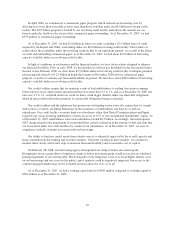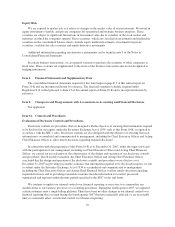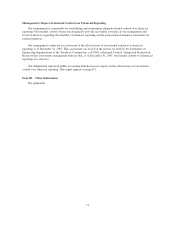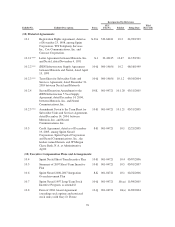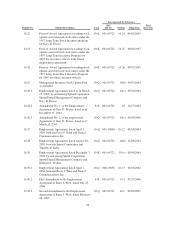Sprint - Nextel 2007 Annual Report Download - page 70
Download and view the complete annual report
Please find page 70 of the 2007 Sprint - Nextel annual report below. You can navigate through the pages in the report by either clicking on the pages listed below, or by using the keyword search tool below to find specific information within the annual report.• potential material purchases or redemptions of our outstanding debt securities for cash; and
• potential material increases in the cost of compliance with regulatory mandates.
Any of these events or circumstances could involve significant additional funding needs in excess of
anticipated cash flows from operating activities and the identified currently available funding sources, including
existing cash on hand and borrowings available under our existing revolving credit facility. If existing capital
resources are not sufficient to meet these funding needs, it would be necessary to raise additional capital to meet
those needs. Our ability to raise additional capital, if necessary, is subject to a variety of additional factors that
cannot currently be predicted with certainty, including:
• the commercial success of our operations;
• the volatility and demand of the capital markets;
• the market prices of our securities; and
• tax law restrictions related to the spin-off of Embarq that may limit our ability to raise capital from the
sale of our equity securities.
We have in the past and may in the future have discussions with third parties regarding potential sources of
new capital to satisfy actual or anticipated financing needs. At present, other than the existing arrangements that
have been described in this report, we have no legally binding commitments or understandings with any third
parties to obtain any material amount of additional capital.
The above discussion is subject to the risks and other cautionary and qualifying factors set forth under
“— Forward-Looking Statements” and Part I, Item 1A “Risk Factors” in this report.
Financial Strategies
General Risk Management Policies
We primarily use derivative instruments for hedging and risk management purposes. Hedging activities may
be done for various purposes, including, but not limited to, mitigating the risks associated with an asset, liability,
committed transaction or probable forecasted transaction. We seek to minimize counterparty credit risk through
stringent credit approval and review processes, credit support agreements, continual review and monitoring of all
counterparties, and thorough legal review of contracts. We also control exposure to market risk by regularly
monitoring changes in hedge positions under normal and stress conditions to ensure they do not exceed
established limits.
Our board of directors has adopted a financial risk management policy that authorizes us to enter into
derivative transactions, and all transactions comply with the policy. We do not purchase or hold any derivative
financial instruments for speculative purposes with the exception of equity rights obtained in connection with
commercial agreements or strategic investments, usually in the form of warrants to purchase common shares.
Item 7A. Quantitative and Qualitative Disclosures About Market Risk
We are primarily exposed to the market risk associated with unfavorable movements in interest rates,
foreign currencies, and equity prices. The risk inherent in our market risk sensitive instruments and positions is
the potential loss arising from adverse changes in those factors.
Interest Rate Risk
The communications industry is a capital intensive, technology driven business. We are subject to interest
rate risk primarily associated with our borrowings. Interest rate risk is the risk that changes in interest rates could
adversely affect earnings and cash flows. Specific interest rate risk include: the risk of increasing interest rates on
short-term debt; the risk of increasing interest rates for planned new fixed rate long-term financings; and the risk
of increasing interest rates for planned refinancings using long-term fixed rate debt.
68









